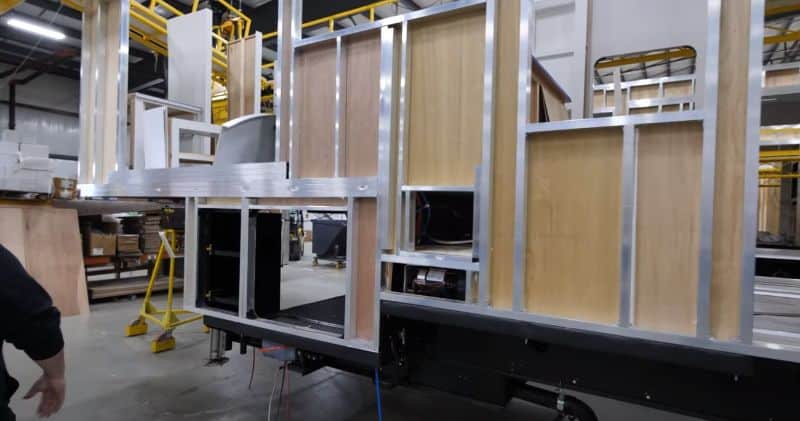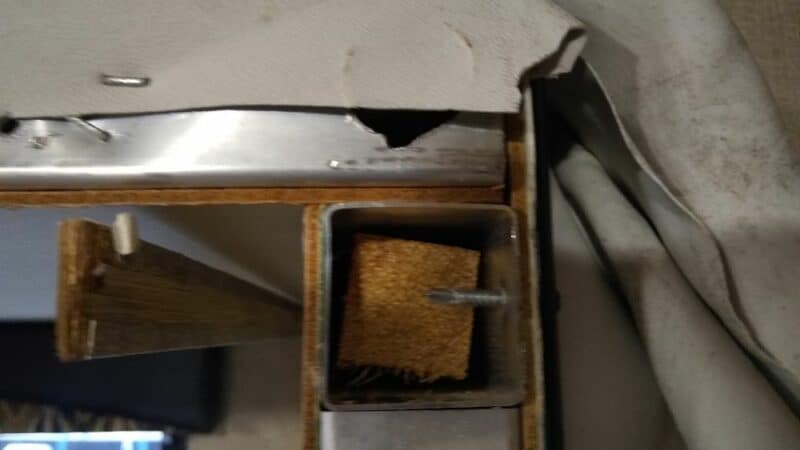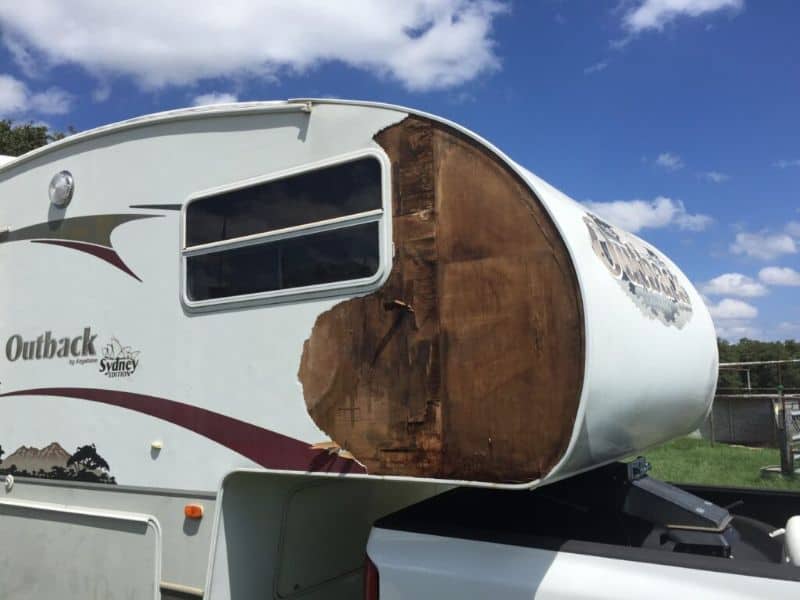The gloves are coming off. I will answer one of the most commonly asked RV construction questions on the web: Is wood or aluminum framing better for an RV?
And the definitive answer is … !!!!
It depends.
Now, wasn’t that anticlimactic? Sorry, I’m an engineer. It’s in my makeup. Engineers never give yes or no answers. We hedge, measure, optimize, debate, and discuss the tradeoffs. But I will tell you that most of the internet has it all wrong!
Is Wood or Aluminum Framing Better for an RV?
Here’s how the question normally gets posed in an internet forum:
“Hey, so, um, I’m shopping for an RV, should I buy one with wooden or aluminum framing?”
And then all the armchair designers chime in and say, “Aluminum is better because it weighs less and it can’t rot,” and then someone else rebuts this claim by saying, “But wood is like how the walls are framed in your house,” and the merry-go-round continues.
Forget all that stuff. I have two big problems with this question. I think it’s misleading.
The biggest problem with this question is that it focuses strictly on the walls and excludes everything else. People get sucked into this vortex of comparing stick n’ tin construction to laminated wall construction. Both, when maintained, can last 30+ years.
But how your sidewalls are constructed is only one piece of the puzzle! What about your floor and roof??
The other big problem with this question is that aluminum is mostly used in laminated wall construction. Calling it “framing” is a little misleading. Unlike a stick-built hung wall, a laminated wall doesn’t depend on framing for strength. It gets its strength from the multi-layer bonding. “Framing” in a laminated wall isn’t like the 2×6 studs in your house that are literally keeping your roof from crashing onto your head at this very moment.
You typically don’t see heavy-gauge aluminum structural framing and hung walls until you get into 5th wheels, luxury toy haulers and Class A motorhomes.
Here’s an example of classic stick-and-tin construction from a walk-through of the 2012 Jayco Jayflight:

Here’s an example of actual aluminum wall framing from Riverside RV:

So there are actually a half-dozen types of sidewall construction that all use aluminum or wood!
Can I Really Buy a Wood-Free RV?
If you’re scared of wood, then I hate to say it, but the sidewalls are just the start!
Because you’ll also have to ensure that your floor framing (if it exists) is made of welded aluminum.
Oh, and that the subfloor decking is made of composite or laminated panels, not plywood or OSB.
And that the sidewalls are also laminated with composite paneling like Azdel instead of luan plywood.*
…. Aaaaaand that the roof panels are luan, too.
Also, the roof trusses should be aluminum or galvanized steel.
Add to that the roof decking should be fiberglass or composite paneling.
One last thing – the fiberglass cap, if present, should have a composite backer.
I guess make all the cabinets plastic while you’re at it?
Did you get all that?
In particular, did you catch that most “aluminum-framed” sidewalls still use luan plywood as a substrate for the interior wallpaper and the exterior fiberglass?
And another thing: Many “aluminum-framed” walls or floors have pieces of wood slid inside some of the hollow tubes for screw retention. See the picture below!

So are you really dead-set on a wood-free RV?
I hope I don’t sound snarky. I’m just trying to get the point across that comparing the benefits of wood and aluminum as construction materials really misses the point that almost every RV is built with wood somewhere!
For instance, if you have a curved roof, there’s a 95% chance that you have ⅜” or ½” plywood or OSB decking underneath your roofing membrane.
There are VERY few RVs built completely without wood in the structure. It’s just not feasible. It’s a niche market. You’d pay twice as much for a wood-free RV (think Oliver fiberglass trailers or Airstream travel trailers*). And when you’re contemplating a $420 or an $840 monthly payment, which do you think most people will choose?
But there’s an even bigger question … Is there anything wrong with wood in the first place?
Should You Be Afraid of Wood in Your RV?
I heard an old story once about house painters griping about the introduction of house wrap (or felt paper, at the time). These painters noticed that new paint was flaking off the clapboard siding on new houses after a year or two. “D*mn housewrap,” they griped. “Housewrap must be killing the paint!”
So it would seem. But what was actually happening was that the house wrap was doing its job! It was stopping drafts. And without those drafts, the clapboarding siding couldn’t air out after a leak. The boards would get waterlogged after a bad rain and a few months later the paint would start flaking off.
(Coincidentally, this is one of the roots of the persistent myth that a house “needs to breathe,” but that’s for another article! Also one of the reasons modern houses use rain screens.)
So the problem wasn’t the house wrap, you see. It was the system as a whole. And so it is with wood in an RV.
There’s nothing inherently inferior about wood framing in an RV. Wood is an amazing renewable construction material.
- Wood is lightweight.
- It’s incredibly strong.
- When kiln-dried, it resists mold and mildew (yes, you read that right).
- It holds mechanical fasteners.
- It glues well.
- It’s affordable.
- It doesn’t off-gas nasty VOCs.
- It can bend but not break.
- Wood is a natural insulator.
(Fun fact: Did you know that you can get a Ph.D. in Wood Science?).
But it’s not adamantium. It can fail. And where wood tends to fail is in high-humidity environments where the four elements required for mold (oxygen, heat, food, spores) are all present.
I’ll be the first to argue that a composite, like Azdel, is an essential upgrade when used as the substrate for your exterior fiberglass. And while not essential, it is preferable to have Azdel (or another composite) as the substrate for your ceiling panels, interior wallpaper panels, and most lamination applications.
But is there anything wrong with wooden cabinetry? Absolutely not!
Wood, when properly used, is a suitable construction material for many types of RV sidewalls. No question about it. I kid you not, some manufacturers have started using aluminum simply because of the perception that it’s a superior product.
So Where Did the Fear of Wood Come From?
Wood gets a bad reputation usually because of bad craftsmanship.
A leaky roof causes the roof decking to turn spongy.
A leaky window causes pine wood framing to mildew.
A gap between the front cap and the subfloor allows the OSB subfloor to absorb rainwater.
So the wood gets blamed for the leak, even if it wasn’t the wood’s fault!
Some RV owners have adopted the mentality that all RVs leak anyway, so may as well buy one that can withstand a leak without disintegrating.
….And regrettably, there’s some truth in that sentiment. Exhibit A:

By and large, the RV industry has accepted leaks as a “part of life.” After 90 days, the customer is in charge of maintaining the sealants. If you get a leak in 9 months, you might be hard-pressed to prove it was a manufacturer’s defect and not your own “lack of maintenance.”
So I don’t blame you for being leery of wood in an RV.
And unfortunately, stapled 2×2 pine wood walls seems to be the construction style of choice for dirt-cheap stick n’ tin travel trailers. And this slap-dash type of construction has given all wood a bad rap.
Final Answer: Is Aluminum Better than Wood Framing in an RV?
Let’s come around full circle. I don’t like the question “Is wood or aluminum better for RV framing?” because it’s a false dichotomy. You’re missing the forest for the trees.
Of all the places to use wood in an RV, wooden wall framing might be one of the least of my worries. I’d pay a lot more attention to the luan plywood used in your sidewalls and ceiling panels. And then I’d check out the OSB used for the subfloor and roof decking.
But if you were to tie me down and force me to answer the question …
“Do I prefer having aluminum framing in a sidewall?”
Yes, I do. That’s mostly because A) aluminum is always the same shape, B) it’s available in any length, and C) it stays straight. It makes manufacturing easier.
But I can’t lie … I do feel better knowing that in the event of a leak, the framing is much more resilient. And if I was totally honest … in my ideal world, I would have a wood-free camper. I just don’t know if I would be willing to pay for it.
Leave a Reply